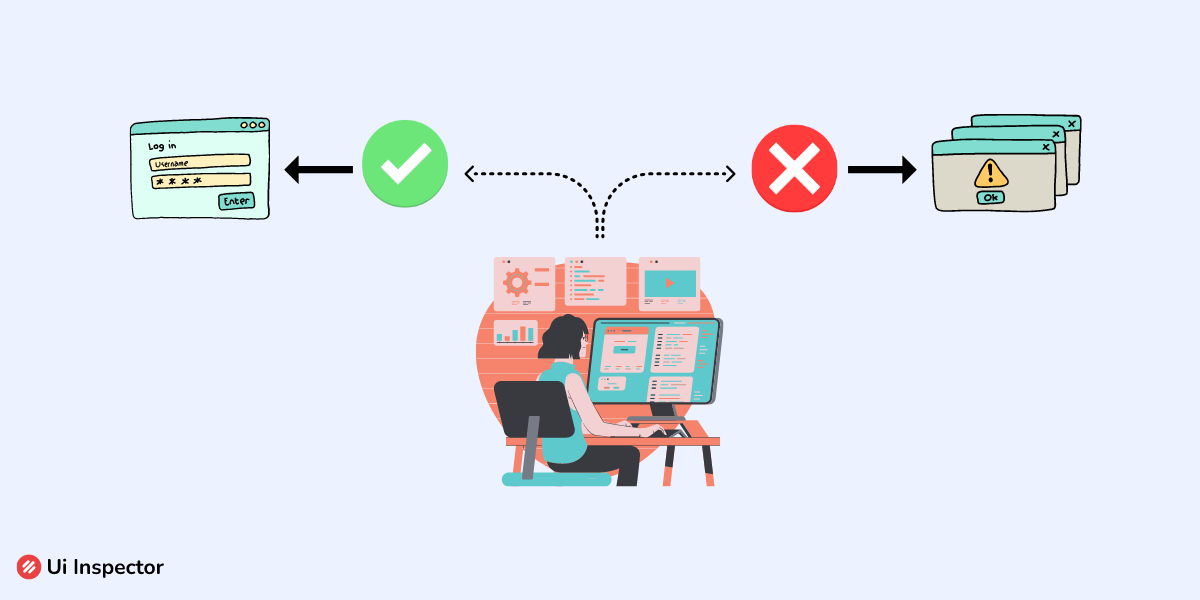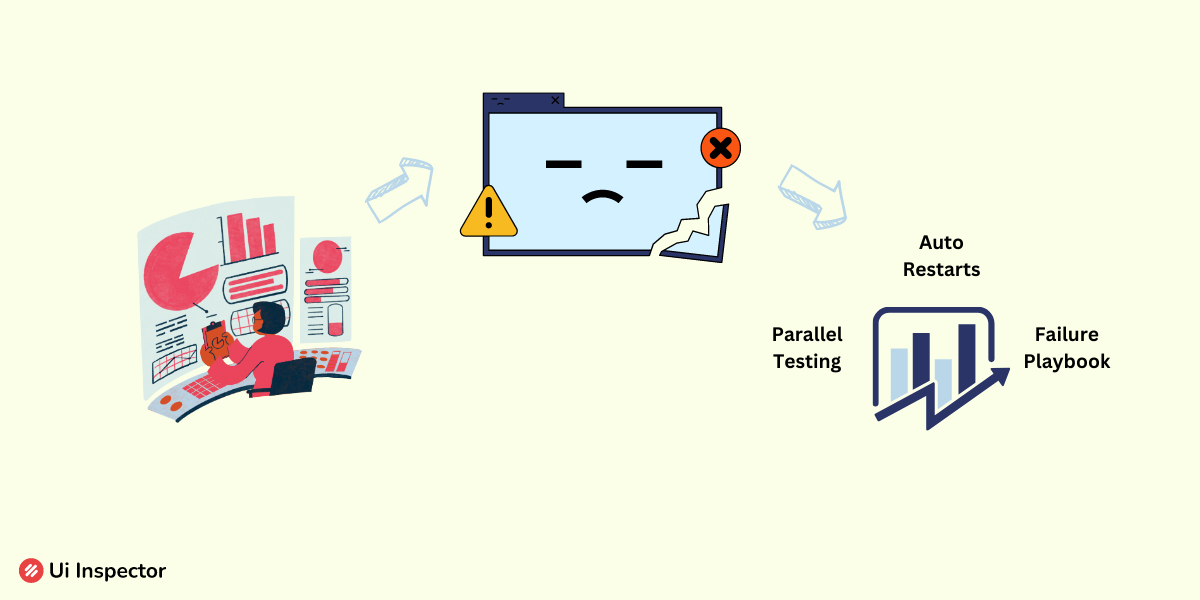A new product or software is mainly focused on the target audience. Any development that is initiated is based on the target audience. So before creating any software, the team usually conducts a research survey to understand what the users need.
But what will the expectations be after the software is released? For every company or organization, it is essential to sustain the local audience of their product. The developers and the testing team constantly work towards achieving what the users want.
To constantly update the software to enhance the user experience, software testing is a crucial step. More specifically, for the local audience, the testing method that is carried out is called localization testing.
This article will explain in detail what localization testing is and its importance in software testing.
Table of contents
- What is Localization?
- Localization Testing: Definition
- Best Practices for Localization Testing
- When is Localization Testing done?
- How to Write a Localization Test?
- Types of Localization Testing
- Benefits of Localization Testing
- Disadvantages of Localization Testing
- Examples of Localization Testing
What is Localization?
Every small region in a continent or a country differs in its culture, language, and lifestyle. The people and businesses are also developed so that it reflects and is useful for that region.
This process, where the product or service is focused on the locality's culture and lifestyle, is called localization. Satisfy users and improve their experience; the service's main goal will be to satisfy them.
Apart from the website's application, the content and language incorporated will also reflect that particular locality. Localization makes it easier for the developers to create and provide a product that requires the local people of that region.
Localization is implemented to make a particular product globally available. It is ideally considered a small step towards achieving globalization.
Localization Testing: Definition
Whenever a product is made available for public use, the next step is to test whether it is bug-free. Here, the QA team implements different testing strategies to provide the best user experience without any hindrances.
As the name and definition of localization suggest, this type of testing is mainly designed based on that particular locality. Localization testing considers the users' culture, language, and behavior and tests the product accordingly.
The test cases under localization testing also vary from place to place and must be customized accordingly. The main aim of localization testing is to ensure a localized experience for the users under that level.
As soon as the product is upgraded, it is no longer necessary to perform localization testing. However, this is the foundation for creating and testing any product.
Best Practices for Localization Testing
To achieve the best results out of localization testing, certain practices are being followed by the QA team,
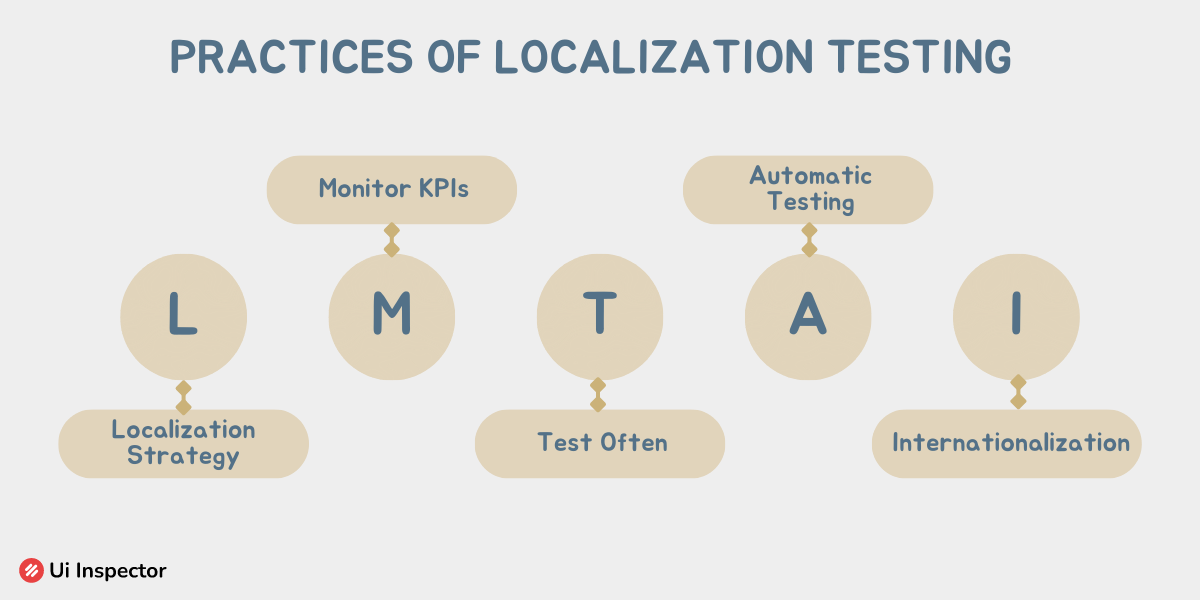
1. Localization strategy
Testing begins with defining its scope and outlining how the test will be conducted. So it is essential to build a test strategy so the workflow can proceed without errors.
A test strategy should contain all basic information about the test case, like,
- The scope of the test
- Tools required for testing
- Browsers and operating systems required for the testing process
- The software application used for test localization
- The teams that will participate in testing
- The local transitions used during the testing process
2. Monitor localized KPIs
KPIs, abbreviated as Key Performance Indicators, are essential metrics to monitor software quality and performance. From region to region, the KPIs differ, so appropriate metrics have to be chosen relative to the locality.
Monitoring the KPIs also helps you to keep track of how the software functions. Specific features or domains can also be monitored with the right KPIs the QA team chooses. The commonly used KPIs for testing are,
- Time KPIs
- Quality KPIs
- Cost KPIs
- Business impact KPIs
- Digital performance KPIs
3. Test often and early
Testing is done to find the errors present in the software and rectify them. The sooner the bugs are found, the better the user experience. Localization testing is also done to locate the bugs in the website.
To get effective testing, localization testing is implemented in the initial stage of software development. Similarly, frequent test cases should be designed and implemented on the software for better results and high productivity.
4. Automatic testing
As we know, localization testing is carried out based on the culture and lifestyle of a particular region. So the test cases should also be designed accordingly. A more complex and tedious process is involved with this testing.
Automation of localization testing will reduce the process's complexity and simplify the procedure. There won’t be any need for manpower during testing to monitor if the process is done as per the strategy.
5. Internationalization
For any product to be accepted worldwide, its success should be shown at the ground level. So for your software to be spread globally, the local people should accept and use the product without any problem.
Localization is considered the first step towards internationalization. So the development and testing steps are concentrated a lot to find a way for global recognition.
When is Localization Testing done?
The main scope to perform localization testing is to alter the software based on the requirements of the local people. So the test process considers various parameters such as,
- User interface: The user interface is where the users fulfill the expectations they require from any website or software. This user experience varies from place to place, and the testing is done to identify what exactly is needed by the community.
- Content: The content that is present in the software should be relative to the culture and lifestyle of the people in that region. The features of the website should be built in such a way that it should relate to the locality.
- Language: The software language must be compatible with the community’s language because people should quickly understand and relate to it.
When these three parameters are under the compatibility of the locality then the localization testing is a success.
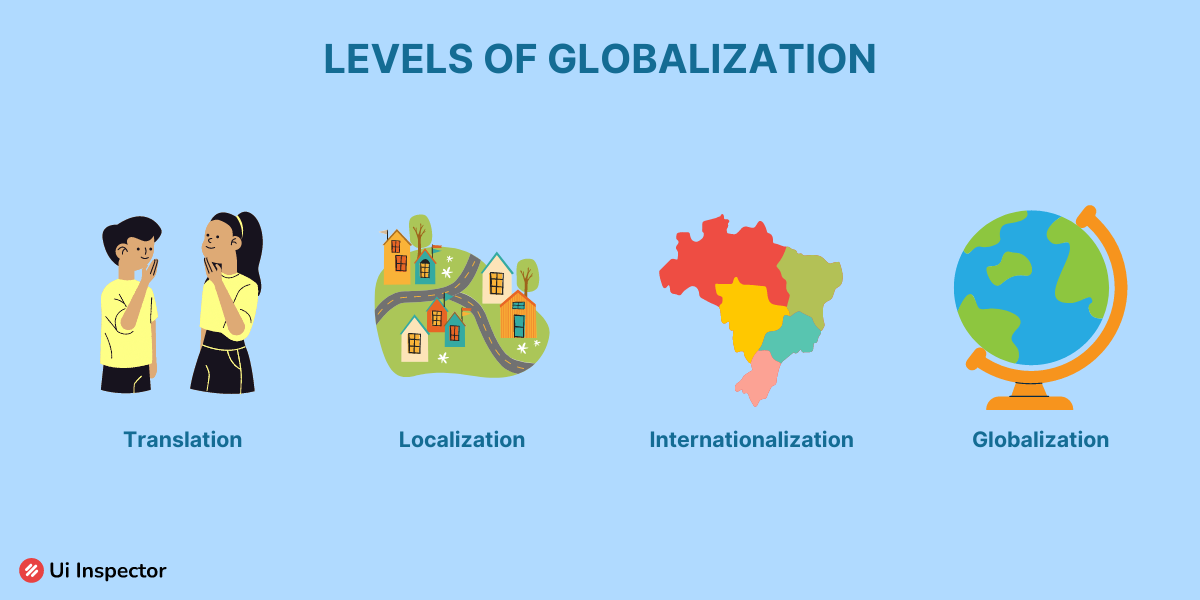
The next step of localization is moving toward global acceptance. When the software you developed is tested with a new audience, then there will be a lot of expectations and errors identified by the users.
In this case, localization testing should be carried out by changing the test cases. The software's features are changed according to the new region’s compatibility, including language, symbols, icons, text, graphic design, etc.
How to Write a Localization Test?
Creating a localization test consists of a few steps, which offer a perfect workflow in the software when followed correctly. Let’s look at how the testing process proceeds,
- The first step towards creating any test process is identifying the test environment. In localization testing, the region and where the test is to be conducted should be finalized first.
- The product that should be tested has to be researched properly. Many parameters relevant to the locality should be considered for choosing the product.
- The outline of the test process is constructed based on the information collected. The test script is also written in the localized language of the community.
- To check the quality, a comparison is done between the parameters of the local community with the other regional standards. This helps in finding what exactly is required by your test audience.
- The final step is the analysis of the report that is obtained from the test. When the comparison is successful, the product can be used; if not, changes must be made accordingly.
We all know that new software and application are developed frequently. The success of a product varies from place to place. To find the right application of your product multiple tests are done.
It is always better to carry out an automatic localization testing process to simplify this. When an automatic process is implemented, it is usually coordinated with other testing methods like usability testing, assertion testing, cross-browser testing, etc.
Types of Localization Testing
We can see a long list of types of digital products. So the testing methods differ from the product type being tested. The testing team should carefully choose the testing method for the particular product and location.
The localization testing also varies based on the digital product being tested. The types are as follows,
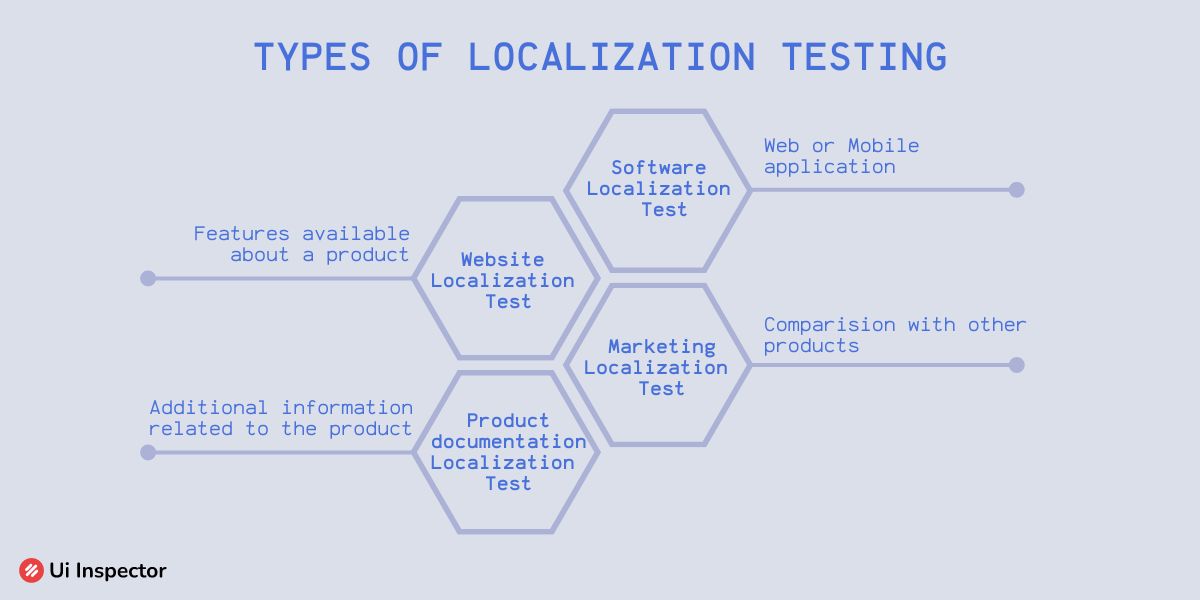
1. Software localization testing
The developer's team created a software product with various integrated components serving various applications. A small error in any one of the components can disturb the function of other components.
To execute software localization testing for your product, the key parameters that should be considered are the UI elements, splash screens, tooltips, and other features related to the target market.
2. Website localization testing
The number of products that are invented is increasing at a faster pace. You can find all the information about the product on the website for each product. So the customers look for the website once they need the product.
The information and layout of the website should be designed in such a way that it will attract local people. Website localization provides the right images, videos, and visual elements that are relevant to the locality.
3. Marketing localization testing
When you create a product it should be spread to other regions and country. The best way to promote your product or software is by marketing it to other communities, which has to be done with respect to their culture.
Marketing localization analyzes the difference found in other regions and helps us create a marketing strategy relevant to that region. So the target audience can also be widened.
4. Product documentation localization testing
It is important for the audience to know how to use your product and there has to be a proper explanation about the features. Documentation is also an important part of developing any product.
Additional content such as frequently asked questions, guides, blogs, manuals, etc should be written so that people can easily understand it.
Benefits of Localization Testing
As the definition and the name suggests, you may think this testing type is confined to a smaller region and revolves around a particular target audience. But that is not the case, this localization testing consists of various advantages.
- Create new products: When you establish your product in a smaller area, you will know the pros and cons to further improve your territory. This leads to a way for newer investments and expanding your market.
- Challenges: As you finish facing your local competitors, this localization testing prepares you to face global competitors.
- Better user experience: Since a smaller audience is focused, you can understand all their needs and make changes according to their requirements. So it is easy to improve the user experience.
- Increase in revenue: When you establish a strong foundation, moving and creating newer regions will be easy. This automatically increases the revenue and ensures you gain profit from your product.
- Saves time: Usually localization is carried out during the initial stages of development, so this identifies bugs and errors faster thus saving time for other testing procedures.
Disadvantages of Localization Testing
The testing process also contains a few cons,
- The testing process requires a lot of expert knowledge to find the best procedure that is suitable for the product.
- Since it differs from place to place, new test cases should be designed frequently.
- A highly experienced and knowledgeable QA lead is required.
- Information analysis and storage differ from place to place, so various challenges are faced by the team.
Examples of Localization Testing
- Blog content present on the website should be relevant to the locality. For example, when it is viewed by the US audience the currencies should be in dollars, and for the Europe audience, it should be in euros.
- When the country changes the brand name also differs as preferred by the audience. For example, top brands like coco cola are referred to as Coke in certain regions coco cola in other places.
- Glossaries and the meaning of the words should be relevant to the native language that is spoken in that particular region. Because the meanings of words differ significantly in different regions.
- Time should be formatted correctly as per the country. For example, in India IST is followed, whereas in other countries it is according to GMT.
- The phone numbers and their codes are also of great importance. Providing a code not relevant to the region will not satisfy the users.
Conclusion
The efforts that are laid by every developer are tested by the users of that particular product and the ultimate success depends on how the audience reacts. Every change that is being made is associated with the preferences and interests of the target audience.
A product is not intended to attract all users and people. Sometimes it depends on the people, culture, and locality they live in. The product could be of great use, but if they don’t understand then there is no use in launching it in the product.
Testing and research are always recommended to avoid this kind of problem. Localization testing is one such testing method that is designed just to win a particular target audience. This is a simple process that generates results, which greatly influences and improves the UX of your digital product.
Seamless Testing with No-Code Platform
Ui Inspector is a no-code test automation platform that accelerates testing processes, increases test coverage, enables continuous testing, delivers reliable test execution, provides actionable insights, and optimizes costs and resources.
It supports comprehensive end-to-end tests that span multiple layers of an application, ensuring critical functionalities are thoroughly tested.
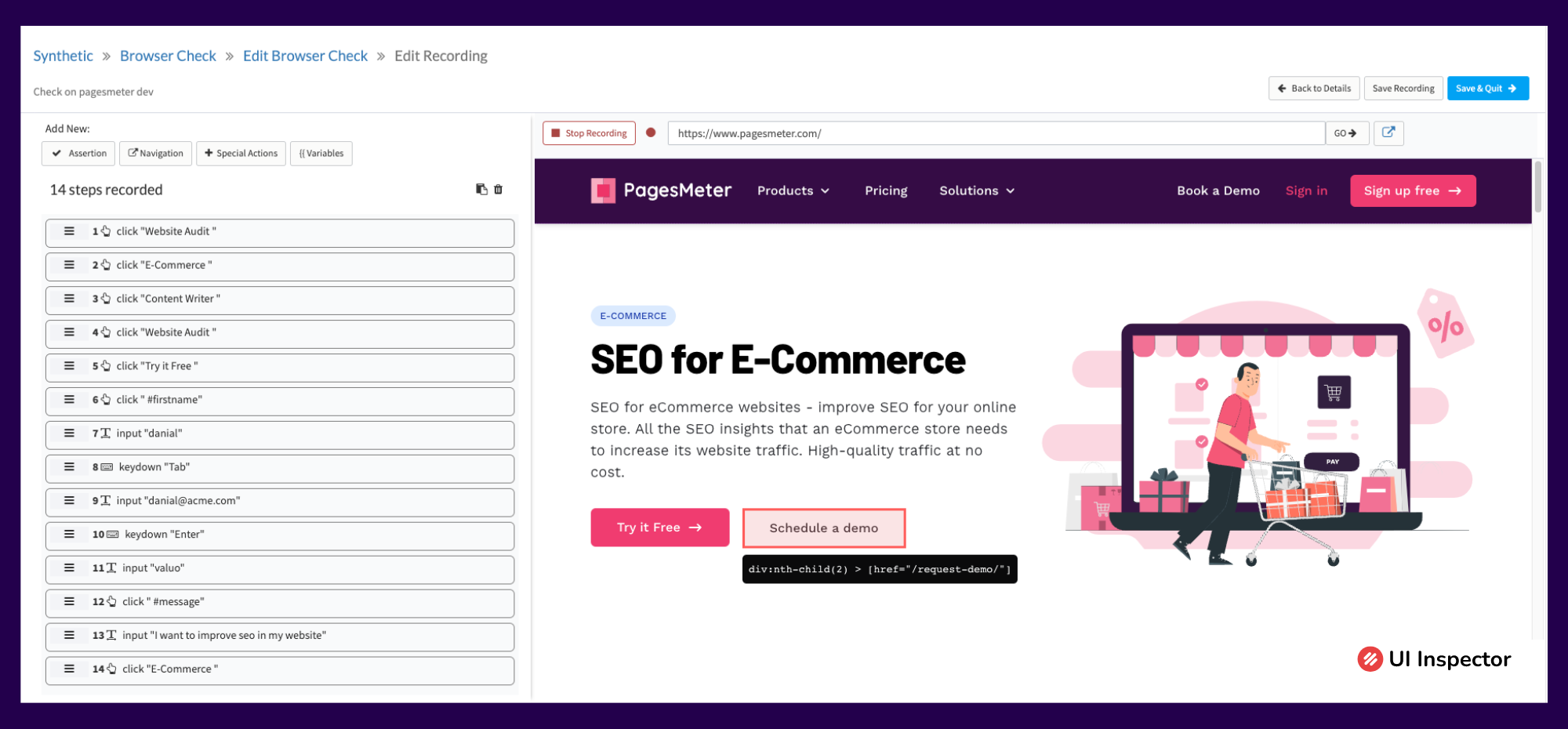
Its user-friendly interface allows non-technical users to create and run automated tests effortlessly. This empowers individuals from various roles to contribute to the testing process effectively.
With Ui Inspector's AI-powered test generation capabilities, test creation, and execution become faster, enabling teams to release high-quality software at an accelerated pace.
Sign up now for UI Inspector's 14-day free trial offer and experience the power of its features to discover limitless possibilities!



